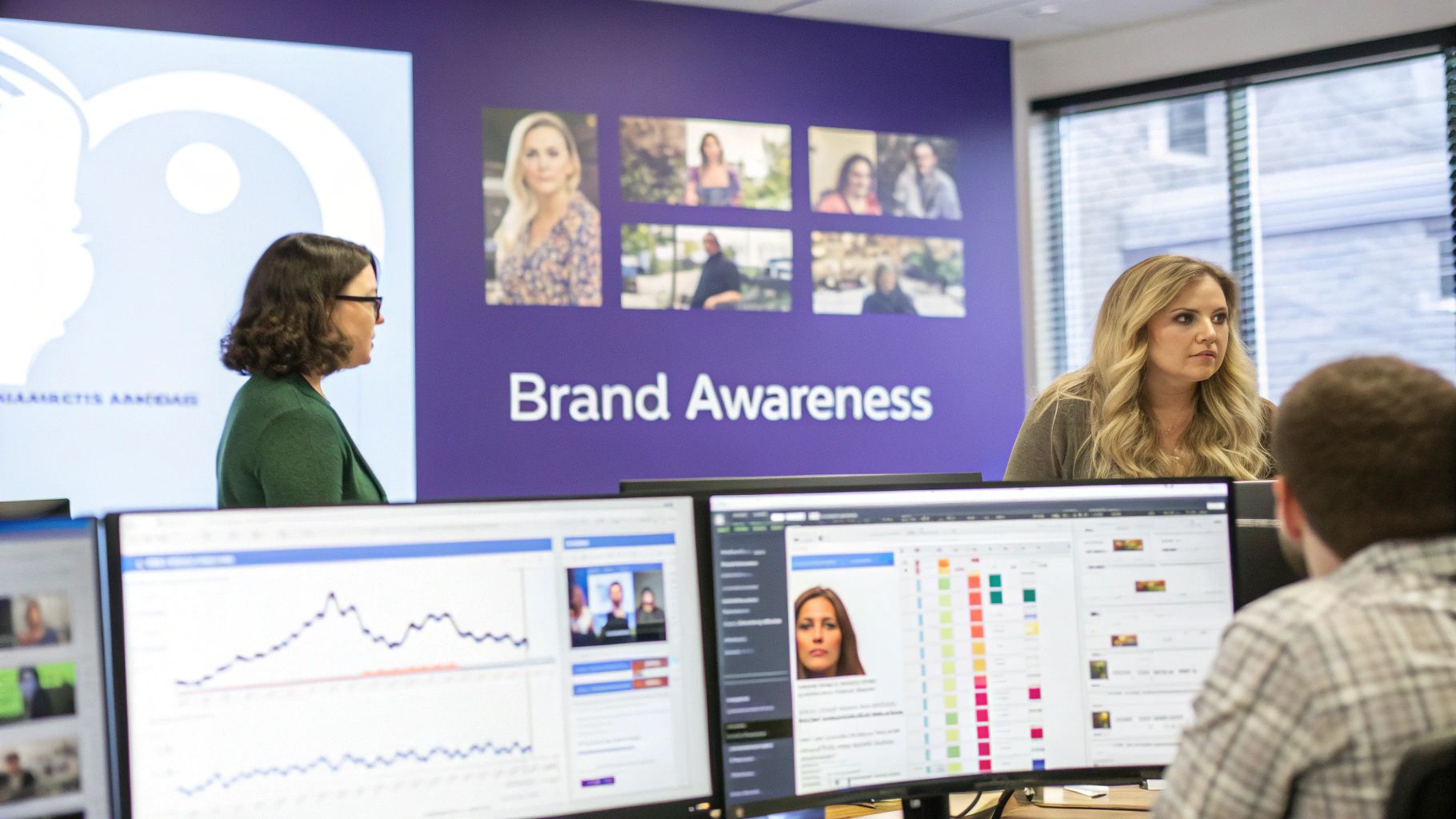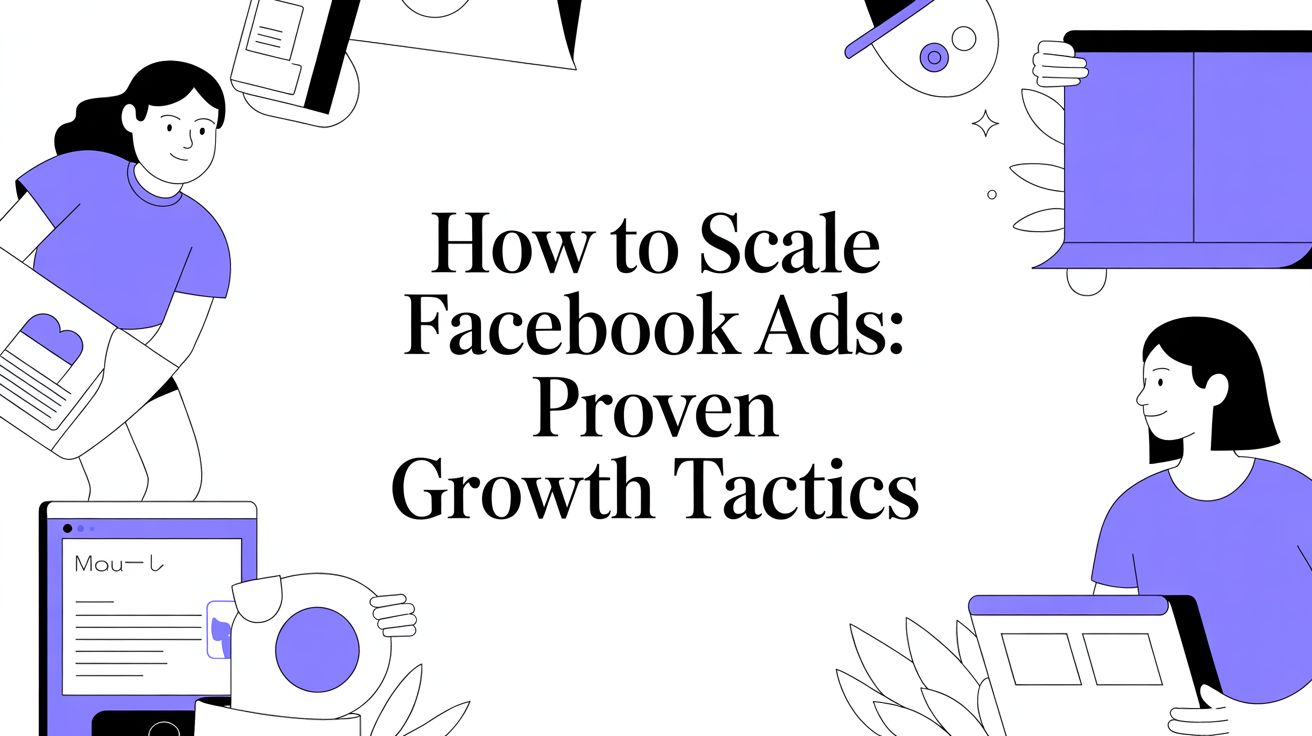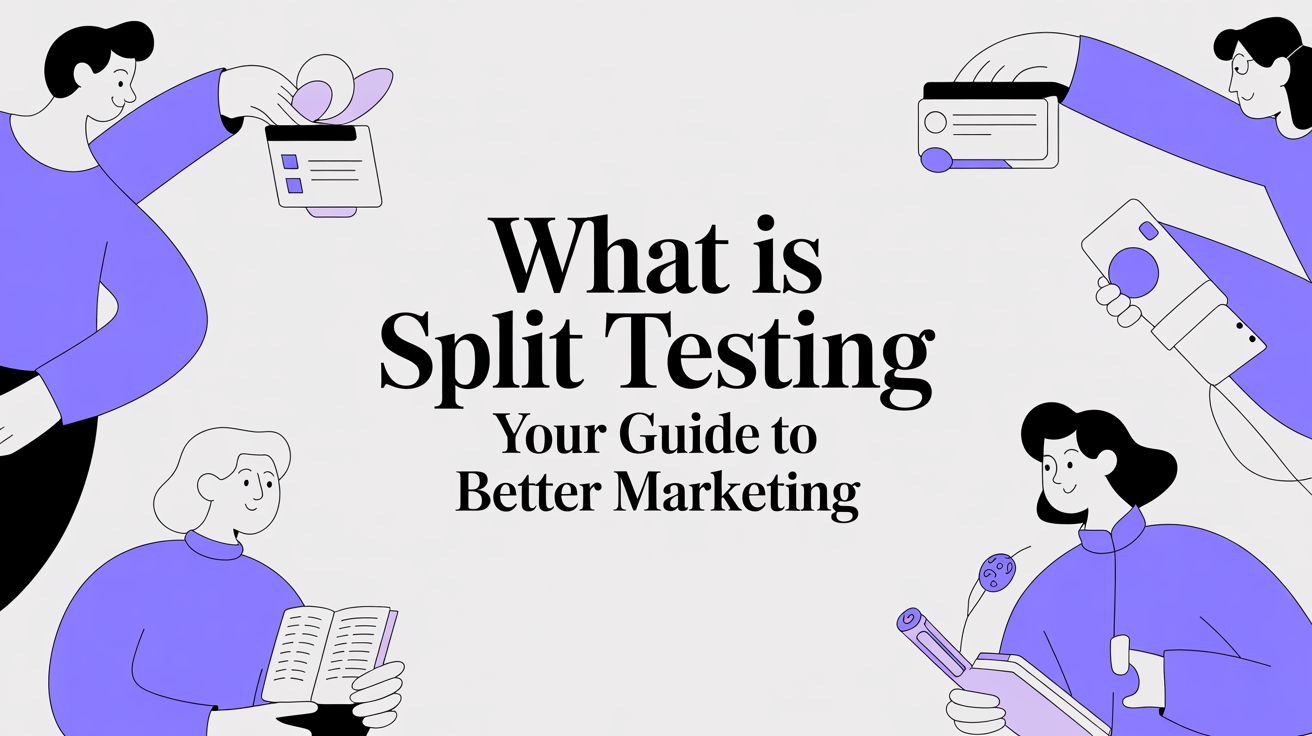Getting people to remember your brand comes down to two things: trust and consistency. It’s the difference between being just another name someone scrolls past and becoming the brand they actively look for. To get there, you need a clear purpose, a consistent voice, and a real understanding of what makes your audience tick.
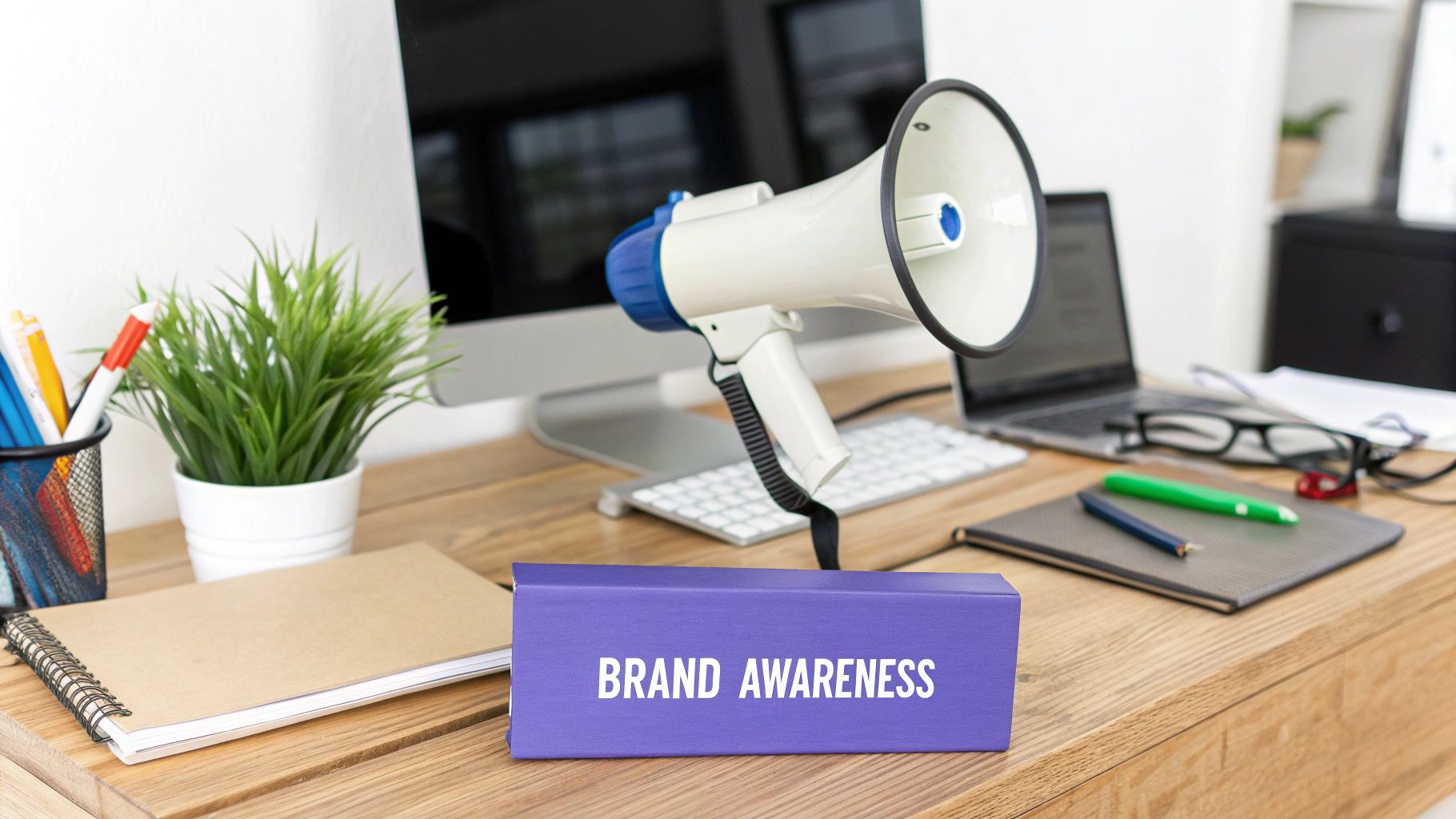
Before you can build a memorable brand, you need a solid plan. I've seen countless campaigns fizzle out because they skipped these foundational steps. This table breaks down the core pillars you absolutely need to get right from the start.
Key Pillars of a Brand Awareness Strategy
| Pillar | Objective | Key Metrics |
|---|---|---|
| Brand Foundation | Define your mission, voice, and visual identity for consistency. | Brand mentions, sentiment analysis, direct traffic. |
| Audience Targeting | Pinpoint exactly who you're trying to reach and where they hang out. | Engagement rate, follower growth, website demographics. |
| Content Strategy | Create valuable content that resonates with your target audience. | Social shares, reach, impressions, time on page. |
| Promotion & Outreach | Actively get your brand in front of new eyes through multiple channels. | Referral traffic, influencer engagement, media mentions. |
Think of these pillars as your blueprint. Nailing each one ensures your marketing efforts are cohesive and effective, not just scattered noise.
Establish Your Brand Foundation
Before you even think about running a campaign, you have to define what your brand is all about. This isn't just about a slick logo or a snappy tagline; it's the core of your business. This foundation becomes your guide for every piece of content, every social media comment, and every customer email, making sure everything feels like it’s coming from the same place.
This kind of consistency is how you build trust, and trust is everything. Consider this: 81% of consumers say they need to trust a brand before they'll even think about buying from it. And with 50% being more likely to buy from brands they already know, it’s clear that familiarity directly fuels your bottom line.
A brand is no longer what we tell the consumer it is—it is what consumers tell each other it is. Your foundation ensures they're telling the right story.
Define Your Core Mission and Voice
Start with your brand’s mission—your "why." What's the reason you exist beyond making money? Are you here to make a complicated process simple? To push for sustainability? To bring a community together? Getting this down on paper helps you connect with people who believe what you believe.
With your mission in place, you can craft a brand voice that brings it to life. Are you going to be:
- Authoritative and educational? Like a go-to industry expert.
- Playful and witty? Like a clever friend who’s always in the know.
- Inspirational and empowering? Like a motivational coach pushing them forward.
Whatever you choose, stick with it everywhere. Think about how Dollar Shave Club used a bold, funny voice to completely shake up the stuffy grooming industry. That was no accident; it was a deliberate choice that made them unforgettable.
To really nail these foundational elements, it’s worth exploring these modern strategies to increase brand awareness. Getting these early steps right is the key to building a brand that doesn't just get fleeting attention but earns lasting loyalty.
Creating Content That Builds Your Reputation
Great content is the engine that drives brand awareness. It’s out there working for you 24/7, answering your audience’s questions and quietly building your reputation as a trusted authority. To make this happen, your strategy has to be about more than just chasing keywords. It’s about creating real value that naturally pulls people into your world.
It all starts with identifying your pillar content. These are the big, meaty, in-depth pieces that become the foundation of everything else you create. Think of a massive "ultimate guide," a report with original research, or a super-detailed case study. These are the assets you'll later slice and dice into social media posts, infographics, and short videos, keeping your message consistent everywhere.
Develop a Content Calendar That Actually Works
A content calendar isn't just a schedule; it's your game plan for consistently solving your audience's problems. Stop guessing what they want to know. Use tools like Google's "People Also Ask" feature, check out AnswerThePublic, or better yet, just talk to your customer service team. Find out what questions they're tired of answering—that's your content goldmine.
Once you have a list of topics, slot them into a calendar that mixes up different formats and themes. A solid plan means you're not just posting at random. You're systematically building a library of resources that cements your brand as the go-to expert. For smaller companies, a smart approach to small business content marketing can be a total game-changer.
Choosing the Right Content Formats
Let's be real: not all content is created equal. The format you pick can make or break how well your message lands. The trick is to match the format to both the topic and the platform where your ideal customers are actually hanging out.
Here are a few formats to consider putting into your mix:
- Deep-Dive Blog Posts: These are perfect for complex topics where you can really flex your expertise and start ranking for those valuable long-tail keywords.
- Infographics: Got a lot of data or a complicated process to explain? An infographic makes it digestible, visually appealing, and super shareable.
- Video Content: Nothing beats video for tutorials, product demos, or just telling your brand’s story with a human touch.
- Checklists and Templates: People love these. They’re practical, instantly useful, and get shared like crazy because they provide immediate value.
The secret is to create a blend of formats that keeps your audience coming back. A detailed article builds authority, while a quick checklist solves an immediate problem. You need both to build a strong brand.
At the end of the day, effective content marketing builds brand awareness because it creates familiarity by being genuinely helpful. Research shows that it takes about 6 to 7 impressions for a brand to really stick in someone’s mind. On top of that, companies that blog consistently generate 67% more leads, proving that teaching your audience is a direct line to winning them over. You can find more branding statistics on wisernotify.com.
When you consistently provide answers and solutions, your content does more than just inform—it builds the trust that turns a casual browser into a loyal fan.
Growing Your Reach with Social Media and Influencers
Social media isn't just a bulletin board for company news anymore. It's where you can build a real, living personality for your brand. The key is to stop broadcasting and start having genuine conversations where your ideal customers are already hanging out.
This means being strategic, not just throwing content at the wall to see what sticks. Pick the channels that actually make sense for your brand's voice and audience. If you're a visual brand, you absolutely need to be on Instagram and TikTok. If you're a B2B service, LinkedIn is probably your sweet spot. The real magic happens when you understand what each platform's algorithm wants to see, which helps you get your content in front of more people. For a deeper dive, check out our guide on how the social media algorithm explained works.
Finding Authentic Influencer Partnerships
Beyond your own channels, partnering with influencers is a fantastic way to connect with communities that already trust someone. But the days of just paying for a quick shout-out are long gone. Today's audiences can sniff out a fake partnership from a mile away. Success comes from finding creators whose audience and values genuinely align with your own.
Think of it as a true collaboration, not just a transaction. I've often found that micro-influencers (those with 10,000 to 100,000 followers) are the hidden gems. They tend to have sky-high engagement rates and a community that hangs on their every word. A recommendation from them feels more like advice from a trusted friend than a stuffy ad.
This chart breaks down the different tiers of influencers by their follower counts.

As you can see, you can work with anyone from a "Nano" to a "Mega" influencer. Each tier offers a different kind of reach and engagement, so you can really dial in your strategy based on what you're trying to achieve.
The best influencer partnerships don't interrupt the conversation; they become a valuable part of it. The audience should feel like they're discovering your brand through a creator they already trust, not being sold to.
Measuring the Real Impact
So, how do you make these collaborations feel authentic? It's simple: ditch the rigid scripts. Give influencers the creative freedom to weave your product into their content in a way that feels natural to them and their audience. This builds far more credibility and makes the endorsement stick.
The power of social media in this process is undeniable. The data backs it up—a whopping 77% of consumers say they're more likely to buy from brands they follow on social media. With 34% of brands already running influencer campaigns to get their name out there, it's a proven path to growth. You can explore more proven strategies to increase brand awareness on social media to get an edge.
When you get these partnerships right, they do more than just give you a temporary visibility boost. They build lasting trust and credibility that helps you stand out, even in the most crowded markets.
Turning Customers into Your Best Marketers
Let’s be honest, your happiest customers are your most powerful and convincing marketing asset. Traditional advertising can feel interruptive, but a genuine recommendation from a real person? That builds a level of trust money simply can't buy. This is where user-generated content (UGC) shines, transforming your audience from passive consumers into active brand advocates.

The whole point is to make sharing their experience with your brand an exciting and rewarding activity. When customers post about your products, they aren't just sharing a photo—they're handing out authentic social proof to their entire network. This grassroots approach is key to growing brand awareness in a way that feels completely natural and credible.
Sparking Community Creativity
To get the ball rolling, you need to give your community a reason to start creating. A simple, yet incredibly effective way to do this is by launching a branded hashtag campaign.
Think of a short, memorable tag that’s unique to your brand or a specific initiative. A local coffee shop, for instance, could use something like #MorningMugshot to encourage patrons to share photos of their daily coffee ritual.
Pairing this with a contest can really ignite participation. You could offer a prize for the most creative photo or video each month, which gamifies the experience and gives you a steady stream of authentic content to feature. Just remember, the goal is to inspire, not to dictate.
Don’t just ask for content; create an experience worth sharing. When you make your customers feel like part of a community, they become your most enthusiastic storytellers.
Featuring Authentic Customer Stories
Once the content starts flowing in, your job is to amplify it. Featuring customer posts on your official social media channels, website, or even in email newsletters is a fantastic way to show appreciation. This simple act validates their contribution and encourages others to join in, creating a powerful, self-sustaining cycle of advocacy.
There are also some serious benefits of user-generated content that go way beyond social proof. It's a smart move to work it into your marketing, especially when you learn that consumers find it 50% more trustworthy and 20% more influential than other media. This is backed up by the fact that 88% of consumers who buy from a brand at least three times become loyal customers—a journey that UGC can beautifully document.
As you build out your UGC strategy, always keep ethics top of mind.
- Always ask for permission before reposting someone’s content. A quick DM is usually all it takes.
- Give proper credit by tagging the original creator in your post and caption.
- Be transparent if you’re running a contest by making the rules clear and easy to find.
By following these guidelines, you build a respectful relationship with your community, ensuring they feel valued, not just used for marketing. This fosters a much stronger connection that pays dividends in long-term brand loyalty.
Building a Strong Local Presence
While it's tempting to chase a global audience, some of the most powerful brand connections are built right in your own backyard. There's a certain magic to a strong local presence that purely digital efforts can't quite capture. When you engage with your community, you show customers you’re more than just a logo—you're a neighbor. This is how you build authentic brand awareness from the ground up.
But what does "local engagement" really mean? It’s not just about digital check-ins. It's about showing up. Think about sponsoring the local Little League team, partnering with that beloved coffee shop on the corner for a promotion, or even just setting up a booth at the weekend farmers market. These are the things that put a human face to your brand, creating real goodwill and making you part of the community fabric.
Optimize for Local Discovery
Let's be real: when someone needs something, their first move is usually a quick online search. That’s why getting your local SEO right is absolutely non-negotiable. Start by claiming and meticulously filling out your Google Business Profile. I’m talking accurate hours, great photos, and a clear list of your services.
You also need to actively encourage and respond to local reviews. This isn't just for show; it directly impacts how you rank. When someone searches for "best [your service] near me," your goal is to be the first name they see. A solid local SEO foundation makes sure your digital presence matches your physical one, driving both online traffic and actual foot traffic.
This chart really drives home how effective local strategies can be for key brand awareness metrics, especially when compared to broader, less targeted campaigns.
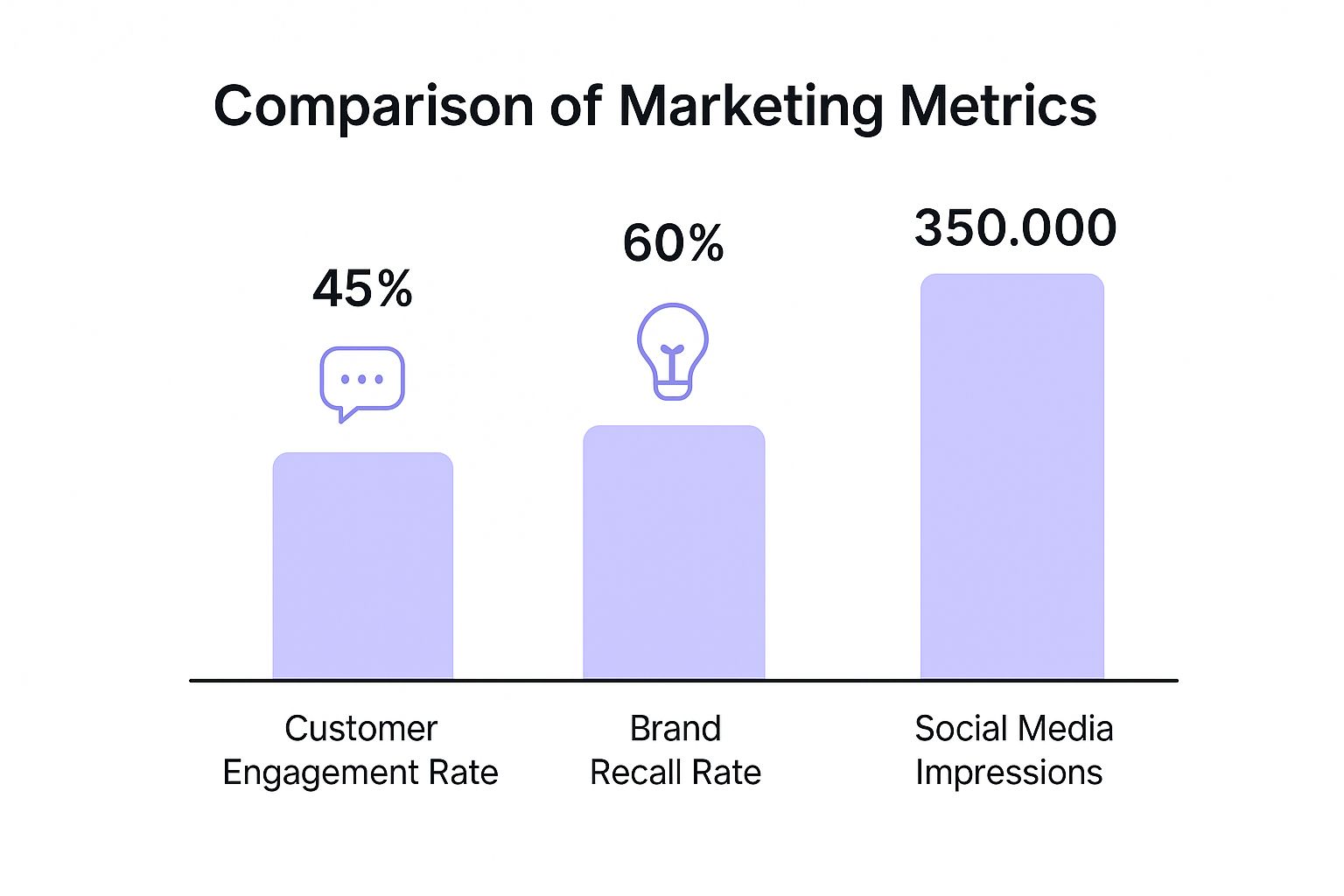
As you can see, a focused local strategy doesn't just bump up engagement—it makes your brand far more memorable to the people who matter most.
This isn't just a hunch; it's a clear trend. Recent findings show that 47% of global consumers now feel it’s important whether a brand is locally owned. Why? The top reasons are a desire to support domestic businesses (36%) and a belief that local brands simply understand their needs better (20%). You can dive deeper into these insights in the full 2025 McKinsey State of the Consumer report.
By embedding your brand into the daily life of a community, you move from being a transactional business to a trusted neighbor. This relationship is the bedrock of lasting local brand awareness.
Deciding between a local or global approach isn't always straightforward. Here’s a quick breakdown of how different tactics play out on each stage.
Local vs Global Brand Awareness Tactics
| Tactic | Local Focus | Global Focus |
|---|---|---|
| Social Media | Geo-targeted ads, community group engagement, local event coverage. | Broad audience campaigns, influencer marketing with global reach, multi-language content. |
| Events | Sponsoring local fairs, farmers markets, neighborhood sports teams. | Attending major industry trade shows, hosting international webinars. |
| Partnerships | Collaborating with other local businesses (e.g., a café or boutique). | Forming strategic alliances with multinational corporations or well-known global brands. |
| SEO | Optimizing for "near me" searches, Google Business Profile, local citations. | Targeting high-volume keywords, creating content for a diverse international audience. |
| Content | Highlighting community stories, customer features, local news tie-ins. | Producing content on universal themes, translating materials, cultural customization. |
Ultimately, choosing the right mix of tactics depends on your specific goals, but a strong local foundation is never a bad investment.
When you truly connect with customers on a local level, you build a resilient support system. These neighbors become your most passionate advocates, spreading the word about their positive experiences. And as we all know, that kind of word-of-mouth is the best marketing you could ever ask for.
So, Is Any of This Actually Working? How to Measure Brand Awareness
https://www.youtube.com/embed/4NqVrn67k5k
Look, all the fancy campaigns in the world don't mean much if you can't tell whether they're actually working. Without solid data, you're flying blind, just hoping for the best. To really know if you're making an impact, you have to ditch the vanity metrics and start tracking the numbers that prove people are paying attention.
I'm talking about moving beyond simple follower counts and post likes. Those feel good, but they don't tell you if your brand is becoming a household name. Instead, you need to focus on metrics that show your brand is gaining real recognition.
The big three I always come back to are direct website traffic, social media share of voice, and branded search volume. These are the tell-tale signs that people aren't just stumbling upon you—they're actively looking for you.
Getting the Full Picture with the Right Metrics
To truly understand your progress, you need a smart mix of hard numbers and human feedback. Combining quantitative and qualitative data helps you see not only how many people are aware of your brand but also how they actually feel about it.
Here are the core metrics you should be watching like a hawk:
Direct Traffic: This is the gold standard. It’s when someone types your website address directly into their browser. Why is this so powerful? It means they remembered you on their own, without any nudges from Google or social media. You can find this data right in your Google Analytics dashboard.
Branded Search Volume: This metric shows how many people are searching for your specific brand name or products on search engines. A steady climb in this number is one of the clearest signs that your awareness efforts are hitting the mark. A tool like Google Search Console is perfect for tracking this.
Social Media Share of Voice: This one is all about context. It measures how much of the online conversation in your industry revolves around your brand compared to your competitors. Social listening tools can handle this for you, giving you a crucial benchmark to see where you stand.
At the end of the day, you're looking for proof that your brand is becoming a real presence in your audience's lives. When people start searching for you by name, that’s when you know you’re building something that lasts.
Don't Forget to Ask: Gauging Perception and Recall
Numbers tell a great story, but they don't tell the whole story. You also need to understand how people perceive your brand. What do they think of when they hear your name?
A simple brand recall survey can work wonders here. You can pop one on your website or send it out to your email list. Ask straightforward questions like, "When you think of [your industry], what are the first brands that come to mind?"
This kind of direct feedback provides insights that analytics just can't give you. It helps you see which messages are sticking and where you might need to tweak your strategy to make a stronger impression.
Got Questions About Brand Awareness? We’ve Got Answers.
Even the most buttoned-up brand awareness strategy runs into a few head-scratchers along the way. It’s completely normal. Let's dig into some of the questions that almost always come up when you're deep in the trenches of building a brand.
"How Long Is This Actually Going to Take?"
Ah, the million-dollar question. The honest answer? Building real, lasting brand awareness is a marathon, not a sprint.
You might get a quick hit from a viral video or a perfectly timed ad campaign, and that's great. But that’s just a spike. True brand recognition—the kind where people think of you first—is built through consistent, steady effort over months, and sometimes even years. It's a lot like building a friendship; you can't rush trust and familiarity.
"Do I Really Have to Spend Money on Ads?"
This one comes up all the time. Can you build a brand without a paid ad budget? Yes. But should you? That's a different story.
Organic growth through great content and social media is the bedrock of a strong brand. But paid ads can pour gasoline on that fire.
Think of paid advertising as a megaphone. It lets you skip the line and get your message directly in front of the right people, right now. This is a massive advantage when you're just starting out and fighting for that initial bit of traction.
Use ads to kickstart your momentum and test what resonates, then let your organic efforts carry the weight for the long haul.
"How Can I Tell if My Message Is Actually Landing?"
This is a huge one. Sure, you can track metrics like reach and engagement, but how do you know if people get what your brand is all about?
You have to listen. Really listen.
Pay close attention to social media comments, dive into customer reviews, and don't be afraid to run a simple poll or survey. The magic moment is when you see your audience start using your own language. When they echo your core values or repeat your key messaging back to you in their own words, you’ve struck gold. That's the clearest signal your story isn't just being heard—it's sticking.
Ready to create stunning video content that grabs attention and builds your brand? With Sprello, you can produce high-converting ads and social videos in minutes, without any filming or complex editing. Start creating today at https://sprello.ai.
